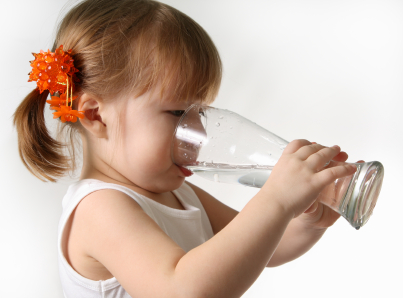Consuming too many calories is actually a greater contributor to obesity than not getting enough exercise. Numerous studies have suggested that individuals are often unaware of how environmental cues, such as plate size, influence eating behavior and perceptions. To better understand what factors influence the amount of food and drink that kids request, researchers Brian Wansink and Koert Van Ittersum explored some well-known visual illusions and discovered that portion sizes are significantly influenced by the size and shape of the containers in which foods and drinks are served.

Beverages—the Shape of the Glass
Individuals, particularly children, are more likely to underestimate the amount of liquid in a short, wide glass than that in a tall, narrow glass; therefore, they drink more from the former than from the latter. In one study children consumed 74% more calories of juice or soda when they poured it into a short, wide glass! Alternately, a tall, thin glass appears to have more liquid and causes the server to pour less.
Tip #1: Use glasses that are tall and thin. They are easier for small hands to hold and will help children and adults consume less unwanted calories … and your jug of orange juice may not disappear so quickly!
Portions—the Size of the Plate
 To put it simply, larger plates and bowls influence people to eat more food. Consider the visual trick depicting two identically-sized circles next to each other. One circle shows a large black dot in the center and the other has a smaller dot in the center. The circle with the larger dot in the center appears to be smaller despite the fact that each outer circle measures exactly the same. This illusion applies to portions on plates. Large plates can cause diners to underestimate calories by 50%!
To put it simply, larger plates and bowls influence people to eat more food. Consider the visual trick depicting two identically-sized circles next to each other. One circle shows a large black dot in the center and the other has a smaller dot in the center. The circle with the larger dot in the center appears to be smaller despite the fact that each outer circle measures exactly the same. This illusion applies to portions on plates. Large plates can cause diners to underestimate calories by 50%!
Tip #2: As with the glass illusion, even those aware of this bias are susceptible to it. Stock your cupboards with smaller plates and bowls to avoid over serving yourself and your family. Encourage all members of your household to use small plates and bowls when serving themselves as well.
Environmental cues can unconsciously bias anyone. Wansink and Van Ittersum’s studies show that children are just as susceptible as adults when it comes to visual illusions. Modifying your home eating environment is the best way to subconsciously influence your family into consuming fewer calories without making them feel shorted.
Contributor
Katherine Baildon, Cornell Center for Behavioral Economics in Child Nutrition Programs
Source
Wansink , Brian, and Koert Van Ittersum. “Do Children Really Prefer Large Portions? Visual Illusion Bias Their Estimates and Intake.” Journal of the American Dietetic Association. (2007): 1107-1110.
Illusion Image provided by: https://commons.wikimedia.org/wiki/File:Mond-vergleich.svg#/media/File:Mond-vergleich.svg
